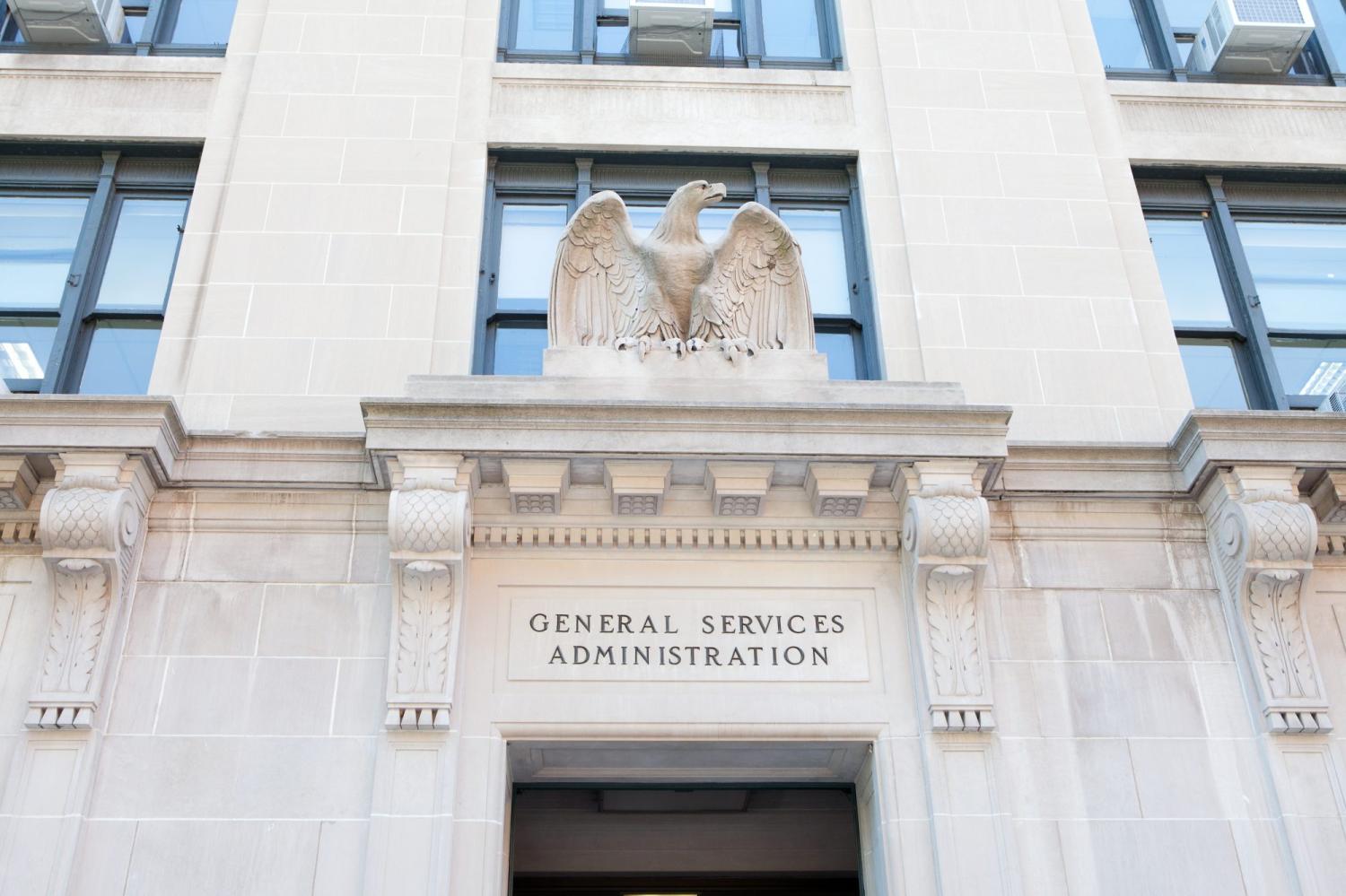It is reasonable to look at programs touting “marketplace efficiencies” with a dose of healthy skepticism, particularly if they become a mechanism for crowding out competitors in the market or, in the worst cases, creating monopolies or oligopolies that deliver neither efficiency nor innovation. Thanks to a series of moves over several presidencies, culminating with President Donald Trump’s first term, federal contracting has become so consolidated that there are essentially 13 people, mostly at the General Services Administration (GSA), who decide which big companies—such as Amazon Web Services, Boeing, Verizon, Northrup Grumman, AT&T, SpaceX, and even Federal Prison Industries—get top-tier status through the government’s most exclusive contract mechanisms. These vehicles are known as Multiple Award Contracts (MAC), Indefinite Delivery/Indefinite Quantity (IDIQ), and/or Governmentwide Acquisition Contracts (GWAC).
Now, we are compelled to consider this consolidation alongside alarming signs of conflicts of interest; for example, in the announcement that the Department of Government Efficiency (DOGE), led by Elon Musk, is not only reviewing the operations and safety systems of the Federal Aviation Administration, but recommending that one of Musk’s companies, SpaceX, get a major new contract.
How is such exclusive and anti-competitive access possible? It’s driven by an obscure but critical procurement policy known as “category management,” which is meant to consolidate buying activity across several verticals within a company or across several agencies within government. Certain contract vehicles are also referred to as “Best-in-Class” (BIC) in the federal category management program if they are available for use governmentwide. Agencies are given recognition based on the use of designated contracting (tiers ranked from 0 to 3) and potentially fiscal incentives, with Tier 3 being the highest form of recognition.
On its face, this system seems like a good idea: It creates economies of scale and initial competition among vendors vying for an exclusive, time-limited slot, which can drive down offering prices. Once the firms have passed vetting, typically through GSA, the selection process and terms are negotiated, and they are placed into a vehicle that is then closed to outside competitors for an initial five years, and possibly five more option years, for a total of 10. When a government buyer from one of the agencies chooses this vehicle, they often can issue a task order directly to one of the companies in the vehicle without having to compete it. This reduces the time it takes for government buyers to select a firm, and their agency gets recognition for choosing a governmentwide (BIC) or agency-wide contract. The firms selected for these vehicles might only be competing for that government buyer’s attention against 40 to 100 other firms, instead of 1,000 to 5,000. Over time, those 100 companies might start carving out their niche within the vehicle and win task orders worth hundreds of millions or billions of dollars.
This process can become anti-competitive because major corporations can afford to cut prices to below or at cost to gain a highly coveted slot in the vehicle, whereas smaller companies that may be on the cutting edge of a technological breakthrough or product innovation are more likely to struggle to compete with such low prices and larger firms’ resources and scale.
The federal government has had a small business set-aside in place known as the “Rule of Two” since 1984, which was around the same time that Congress passed the Competition in Contracting Act. The “Rule of Two” says that if there is a reasonable expectation that two or more small businesses can do the work at a fair market price, then the contract must be set aside only for small businesses to compete. This drove more competition and quality in federal contracting and grew the small business industrial base. It also helped build the nation’s middle class and created millions of meaningful jobs. However, based on the government’s category management principles, a buyer is rewarded by first going to a GWAC or MAC of their choosing, or also creating an IDIQ, which may or may not contain small businesses. Category management will reward them for simply making that step instead of setting aside the contract for only small businesses to compete in the marketplace.
As it currently stands, even if the IDIQ, MAC, or GWAC has small businesses in it, the Rule of Two does not apply. With multiple award vehicles having large ceilings, such as $50 billion, and agencies being incentivized to use those vehicles whether they select a large or small vendor, smaller players become crowded out in the government marketplace. GWACs dedicated only to small or disadvantaged businesses do not fix this problem. Once a large, publicly traded corporation is selected for a GWAC or MAC, they no longer have to worry about small business set-asides as a form of competition. In effect, it can become a set-aside for large corporations, for as long as 10 years and with the use of billions of taxpayer dollars. For example, Space Force, which is under the U.S. Air Force, announced an IDIQ in early April with only three corporations in it and total awards up to $15 billion, despite concerns by the Senate Appropriations Committee regarding the lack of competition in these contract awards.
We are often alarmed by this type of behavior outside the federal marketplace, such as American consumers having only two or three choices for internet and cable providers that each have market caps over $150 billion. Our concerns should be no different for government contracts. Take, for example, medical supplies: If any one company crowds out the medical supply market for government contracts, it will impact small firms vying to compete and potentially put them out of business. It is not long before we feel the effects of this outcome when we shop online or in stores for products and services that the government also buys, such as thermometers, bandages, construction materials, and even laptops. The less competition, the higher the prices.
Over time, category management in the federal government can do—and has done—substantial harm, making the marketplace less competitive and less inclusive, especially for small businesses. Over more than a decade, the federal government—the world’s largest buyer of goods and services—has lost over 90,000 suppliers and service providers. The small business supplier or professional service companies most impacted are typically the most nimble, innovative, and customer-service-oriented firms that do not have the resources to compete against larger contractors. The American people pay a big price for this. Over time, taxpayers, through the government, pay higher prices for less innovation and, too often, less quality and a less competitive marketplace overall. This has spillover effects on private and not-for-profit buyers, such as many colleges and midsized health care systems. Fewer competitors in the marketplace hurts them all.
In 2022, the Small Business Administration (SBA) sought to fix this issue by drafting a proposed rule based on a ruling in the Court of Federal Claims on the Tolliver Group Inc. v. United States case. The army had set aside a contract for small, service-disabled-veteran-owned (SDVOB) firms for fire instruction training. The army issued awards to them, but then later canceled the contract and created a MAC that included only five large businesses. The fire instruction training contract was moved to the MAC. The SDVOBs could no longer compete for the award. Judge Matthew H. Solomson, who President Trump appointed in 2020, ruled in the landmark case that the Army had to apply the small business set-aside criteria (the Rule of Two) before awarding the contract to a large corporation.
After significant pushback from the Office of Management and Budget (OMB) and subsequent extensive negotiations between them, SBA, the White House, and GSA, the federal government arrived at an agreement in 2023 that the Rule of Two would be satisfied if applied within a contract vehicle, and if GSA allowed an on-ramp for small businesses to enter into an otherwise closed and time-limited contract vehicle. The former was drafted as a rule, and the latter as policy.
In October 2024, the proposed rule was issued for public comment. A small, veteran-owned HUBZone firm (a federal certification based on geographic location) had this to say: “The large primes have huge capture and proposal writing teams that [beat] us out of open competition. Small businesses like ours can deliver higher quality service at lower prices than large firms; however, without small business set-asides, we rarely have a chance of beating the large primes on acquisition.”
Another public comment, from an ex-Marine who owns a successful medical equipment firm, indicated that the Department of Veterans Affairs National Acquisition Center is bypassing small businesses in its high-tech medical equipment guidance: “We are in a position to bring value and support to the government with this product group, if allowed to do so,” he wrote. “Currently we are unable until the rules change.”
The most direct way to address these concerns is to finalize the proposed rule right away. But the federal government can also take these additional steps to unwind a policy that runs the continued risk of creating an anti-competitive marketplace:
- Halt consolidation of federal contracts at GSA and restore the Rule of Two.
- Place the SBA on the Federal Acquisition Regulatory Council.
- Undo the cohort of category management “kingmakers” at GSA.
- Appoint a Senate-confirmed deputy director of management at OMB and administrator of the Office of Federal Procurement Policy (OFPP), also at OMB, who are proven champions of small contractors.
How the category management buying practice was born
The federal government began implementing a policy of “strategic sourcing” during the George W. Bush administration. Toward the end of the Obama administration, it was renamed “category management” to echo private sector sourcing strategy. The policy was then embraced and expanded during the first Trump administration, which created scorecards for agencies that met tiered-level contracting requirements. In plain terms, this means that a buyer’s preferred method of contracting will reflect on their agency through recognition, at a minimum, but it is unclear whether it may also include fiscal incentives through the President’s Management Agenda. Tier 0 is the lowest, and Tier 3 is the highest. The more a buyer uses a vehicle that OMB decides is Best-In-Class (BIC), or Tier 3, the more recognition an agency will receive.
In this system favoring the consolidation of contracts, the highest tier is the use of a GWAC—most of which are administered through GSA, but other agencies such as Defense and Homeland Security can create GWACs or MACs. Under this type of vehicle, a select few firms are pre-vetted and pre-negotiated to participate in the vehicle and compete for high-value task orders. These vehicles are typically closed off for five years, and potentially up to 10 years.
The system supporting this contracting practice is muscular and rooted right at the top, in the Executive Office of the President (EOP) in the White House. Agencies such as Defense, Veterans Affairs, and Health and Human Services are incentivized by OMB, which is part of the EOP, to do their purchasing through these vehicles—in principle, to create economies of scale. Since 2017, OMB has claimed that category management saves the federal government close to $10 billion per year.
While category management streamlines the contracting process for government executive buyers and acquisition officers, it also directly contradicts the “Rule of Two.” As previously noted, this is a long-standing practice dating back to the Department of the Navy in 1964 and later being adopted across government in 1984 to ensure access to opportunity and a continued pipeline of innovative companies. This was also around the time when there was a series of Government Accountability Office (GAO) reports and congressional hearings citing an increase in non-competitive bids in federal contracting processes. In a 1981 letter to the secretary of defense, the GAO director stated: “This review was undertaken because of ongoing congressional concern about competition and because of the lack of consistency in reported amounts of competitive DOD contracts.”
In the letter, that GAO director also offered a prescient warning of how market prices are not always as competitive as we are led to believe: “While the market in certain instances may set prices through competition, other forms of market pricing involve monopolies, oligopolies, and cartels where prices are not established through competition.”
In the case of today’s contracting vehicles, prices are established through competition. However, once a firm has landed a coveted spot, it is possible for them to request an official economic price adjustment “when potential fluctuations require coverage” or request an extraordinary contractual action when it is essential for national defense or to correct a contract mistake.
Separately, in 2022, the inspector general for the GSA reported that the agency could not guarantee that it was getting the lowest price from firms for its long-established award schedules, which are considered Tier 2 under category management.
Based on our sample of 19 consolidated contracts, we found that FAS’s [Federal Award Schedule] price analyses for the products and services transferred to consolidated contracts were frequently limited and did not consistently leverage the government’s collective buying power. In particular, when performing price analyses for contracts subject to the [Commercial Sales Practice] requirement, FAS contracting personnel frequently accepted unsubstantiated most favored customer [term of art for government competitive price offering] and commercial pricing information.
In a second report two years later, the inspector general reported that a nascent program GSA launched to conduct price analysis for its consolidated multiple award schedule contracts was lacking considerable controls:
In this report, we found that the data collected through the TDR [Transactional Data Reporting] pilot program was never used to negotiate contract-level pricing. Instead, GSA has amassed a collection of data that is almost entirely inaccurate, unreliable, and unusable. Additionally, we found that GSA’s Fiscal Year 2020 evaluation of the [TDR] pilot program evaluated metrics using flawed methodologies and inaccurate and unsupported information.
Justices had their say with Veterans Affairs
In 2016, this complicated policy issue went all the way to the Supreme Court. A veteran-owned firm named Kingdomware filed suit against the Department of Veterans Affairs for overlooking it in a contract award. Kingdomware had lost a contract opportunity to a large firm in the Federal Supply Schedule, now referred to as Multiple Award Schedules (MAS). The Supreme Court ruled 8-0 in Kingdomware Techs., Inc. v. United States that Veterans Affairs had to apply the Rule of Two for veteran-owned small businesses in all contracting circumstances.
The Tolliver case followed Kingdomware and applied to all federal agencies, not just Veterans Affairs. It also applied to total small business set-asides, which includes all small business designations.
In 2022, Congress finally took note when the House Small Business Committee held a hearing titled “Are Governmentwide Contracts Helping or Hurting Small Contractors?”, and invited small business owners to testify on their experience with these contract vehicles. The business owners indicated that contract management vehicles were choking off their opportunity to fairly compete and depleting their resources. As then Ranking Member Blaine Luetkemeyer (R-Mo.) said at the hearing:
Unfortunately, one of the unintended consequences of the rising use of governmentwide contracts, is [the] exclusionary impact this has on most small contractors and the ensuing negative ripple effects stemming from the loss of this critical cohort of business. Only a limited amount of small contractors are awarded spots on these lucrative, long-term contracts. This leaves the rest locked out of the lion share of federal opportunities.
Noting how this can limit competition and innovation, and ultimately increase costs to taxpayers, Rep. Luetkemeyer added, “It may snowball into broader, more debilitating concerns such as threatening our national security and economy.”
One of the business owners who testified during the hearing, Lynn Ann Casey, the CEO and founder of a woman-owned management firm in Washington, D.C., indicated that the costs are enormous for a firm like the one she owns: “[It’s an] incredible cost to pursue GWACs. [My firm] estimates that it costs us somewhere between $60,000 to $100,000 for each proposal for a governmentwide vehicle.” Further, she indicated that small business owners like her often lose opportunities to recompete for business they already have once the contract is absorbed into a Best-In-Class or GWAC, as in the Tolliver case. Once that happens, she is not able to submit a follow-on proposal for the same contract, which is how most small contractors grow and prosper.
Finally, Rebecca Askew, CEO and general counsel of Circuit Media, LLC in Denver, indicated if a small business owner is fortunate enough to win a slot on a MAC, it doesn’t guarantee that they will get a task order. She likened it to a fishing license: “You can throw your line into the water, but no catch is assured.” For one MAC application, she received 28,000 points—just 100 points shy of gaining entry into the coveted vehicle. She ended her testimony citing just how challenging this environment makes it for women-owned businesses to compete: “The federal government’s acquisition practices are geared towards large companies competing on enormous government buying vehicles.” She continued: “Over 90% of all women-owned businesses are small.”
Shifting anti-competitive procurement policy and safeguarding our future
It remains to be seen whether the Trump administration will follow through on the proposed rule. Right now, the signs are that it is not a priority, and conversely, there are preliminary reports that there will be a move soon to consolidate over $400 billion out of over $600 billion in contracting within GSA. This would effectively outsource nearly two-thirds of contracting activity to the agency that co-created the category management framework, the agency grading system, and the cohort of 13 category managers who decide which companies land a coveted slot into a governmentwide vehicle.
On April 15, President Trump signed an executive order titled Restoring Common Sense to Federal Procurement. But is “restoring common sense” a euphemism for weeding out small businesses from the industrial contracting base, as category management has done over the last decade?
If our leaders are serious about expanding opportunity for hard-working Americans and driving U.S. innovation around the globe, it is critical for Congress and the president to place the following immediate stopgap measures to protect Main Street businesses. These are only initial steps to rein in policies that dramatically limit competition and concentrate an abundance of contracting wealth, but they are a critical start.
Halt consolidation of federal contracts at GSA and restore the Rule of Two
Contract consolidation at GSA will remove authority from federal agencies and provide GSA with a blank check for deciding which companies can become monopolies and oligopolies. This policy must be halted immediately through executive action. In addition, the White House and SBA, also through executive action, should immediately adopt the proposed rule to ensure fair competition within contract vehicles that have businesses of all sizes, most of which are housed at GSA. In addition, the White House and GSA need to ensure that a representative number of small businesses have an on-ramp to all closed multiple award or IDIQ contracts that were issued only to major corporations, so that the Rule of Two can be executed across government. This will place a stopgap measure on contract consolidation among the largest corporations, while the White House and Congress fashion additional measures to ensure a competitive marketplace for talented small businesses.
Place the Small Business Administration on the Federal Acquisition Regulatory Council
The Federal Acquisition Regulatory (FAR) Council consists of the Department of Defense, NASA, GSA, and the administrator of federal procurement policy at OMB. The FAR Council was created in 1994 as part of Title 41 in the Office of Federal Procurement Policy. Congress needs to vote to include the SBA on the FAR Council, and the president needs to sign it into law. This will ensure that small, innovative contractors have a seat at the proverbial “big kids” table. Otherwise, general procurement and small business contracting policies will continue to be disjointed and overwhelmingly favor large corporations that lobby for exclusive, closed multiple award contracts that nullify the Rule of Two.
Undo the cohort of category management ‘kingmakers’ at GSA
Early in the Biden administration, it became apparent that GSA had created a cohort of category managers who decided which companies would make it onto MACs and GWACs. By way of example, the category managers decided to grant Federal Prison Industries (FPI) Tier 2 status in the category management program in late 2020, thus steering agencies to contract with them versus thousands of small business job creators who did not have access to the contracting tiers. FPI, also known as UNICOR, is a government-owned corporation under the Department of Justice that provides jobs to prison inmates. Wages are somewhere around $1.15 an hour. On the other hand, an entry-level position for an employee at a small business that contracts with the federal government starts at around $40,000 to $60,000 per year, the equivalent of $19 to $28 per hour.
Acquisition is so consolidated that the category managers are essentially “kingmakers,” mostly based at GSA, who decide which big companies get top-tier status via the most lucrative contracting vehicles offered by the United States government. This cohort of category managers needs to be dismantled and replaced by the chief acquisition officers (CAOs) of the 24 major agencies, the SBA Office of Government Contracting, and the area directors overseeing the procurement center representatives (PCRs)—a team Congress created to advocate for small contractors among major buying activities. A representative body such as this will ensure that all agencies: 1) have a stake in which companies are chosen for these governmentwide contract vehicles; 2) that there is governmentwide transparency in the selection process; and 3) that there is robust discussion about the implications of such consolidated contract vehicles and the impact on the small contractor industrial base.
Appoint a Senate-confirmed deputy director of management at OMB and administrator of the Office of Federal Procurement Policy, also at OMB, who are proven champions of small contractors
OMB has a director and two deputy directors, each overseeing the divisions of management and budget. All three are Senate-confirmed appointments within the Executive Office of the President. The deputy director of management oversees the administrator of the Office of Federal Procurement Policy (OFPP), also a Senate-confirmed position. Each president needs to make sure that someone who will advocate for Main Street America—not just big and deep-pocketed corporations—is appointed as deputy director of management and administrator of federal procurement policy. These need to be visionary executives who will ensure that the chief acquisition officers of all 24 major federal agencies—as well as OMB, SBA, and the FAR Council—are continuously shaping policies that provide small and nimble business access to the largest purchaser in the world. Our economy depends on it.
Lessons from historic small business innovation, and the path forward
We have been here before. It was 1947 when Congress and the president realized we ran the risk of clustering significant economic opportunity among a select few corporations. As a result, the Armed Services Procurement Act was passed, providing opportunity and protections for small business contractors. Soon after that, the SBA was created, and in 1984, when Congress saw that contracting was becoming less competitive and more consolidated, it passed the Competition in Contracting Act and President Ronald Reagan signed it into law.
The federal government is not alone. Management consulting firms such as McKinsey, Bain and Company, and others have been encouraging major corporations to adopt category management in contracting for a number of years. In one report, McKinsey notes, “the best category managers maintain a profit and loss mindset” and refers to them as “chief strategy officers.” But there are no recommendations in the report for such strategists to spur American innovation among small and up-and-coming businesses. With nearly $7 trillion in contracting opportunities among Fortune 500 companies, the risk of contract consolidation and massive loss of opportunities is even greater than in the federal space.
This is where the federal government can lead instead of follow. The institutions created to preserve our democracy and Constitution know that private sector actors may have a blind spot that overlooks the next Moderna—a small business that invented the first mRNA COVID-19 vaccine—or Adaptive Phage, which just three years ago was a small, cutting-edge biotech company in a race against Russia to develop antidotes to antibiotic-resistant superbugs. Adaptive Phage won $30 million in Defense Department contracts to continue their research and development. These are just two examples of once-small American companies that have had an outsized impact on humanity.
We can be visionary in strengthening the middle class and spurring innovation, just as we were nearly 80 years ago. And we can continue to reverse the decline in the small business industrial base and rebuild it through thoughtful, innovative policies that put our country over corporations.
The Brookings Institution is committed to quality, independence, and impact.
We are supported by a diverse array of funders. In line with our values and policies, each Brookings publication represents the sole views of its author(s).




